Monday, 16th September 2019 – Strasbourg
We had a relatively early start because we’d booked, through AirBnB, to go on a food tour of Strasbourg. I got up even earlier than that though, because I wanted to go for a run. My running schedule has fallen apart recently and I was keen to get back on track. A two week holiday seemed like a good place to start afresh. I headed out of the apartment, and ran into the centre of Illkirch (or possibly Graffenstaden), and at 07:30 found everything was very quiet. I also established that the nearest tram stop was within about 2 minutes of the apartment. This was good because we would be using public transport for the next two days and leaving the car in the underground garage. Half an hour later and I was back, getting showered and ready to go out and explore Strasbourg.

Illkirch-Graffenstaden is in effect a suburb of Strasbourg nowadays but there are suggestions that it’s been in existence since the Franks. It’s named from the river it and Strasbourg are on, the Ill, which is a tributary of the Rhine. Certainly the earliest record of it dates to 720 (Ellofanum) with Illenkirche appearing in 845. Graffenstaden was a village bordering Illkirch: the two communes were merged for economic reasons between 1790 and 1794. It was a centre of heavy industry for a long time, but now seems to be mostly a commuter suburb with added military centre in the shape of the Leclerc barracks (Quartier Leclerc), home to the French 2nd Armoured Brigade and the German 291st Light Infantry Battalion, which make up the Franco-German Brigade, the only military formation permanently under the operational command of corps. a unit of the Eurocorps.

However, we weren’t here to investigate Illkirch or its military installation. We purchased a pair of 24 hour tickets for the tram and bus system (at just over €4 each) and jumped on the first tram leaving. Illkirch is at one end of the 16km Line A which runs from the Parc des Sports past the main railway station all the way to where we were staying and the trams run every 6 minutes during weekdays so we were soon on our way to meet our guide, Pierre, who was due to take us on a 3 hour tour of his home city.
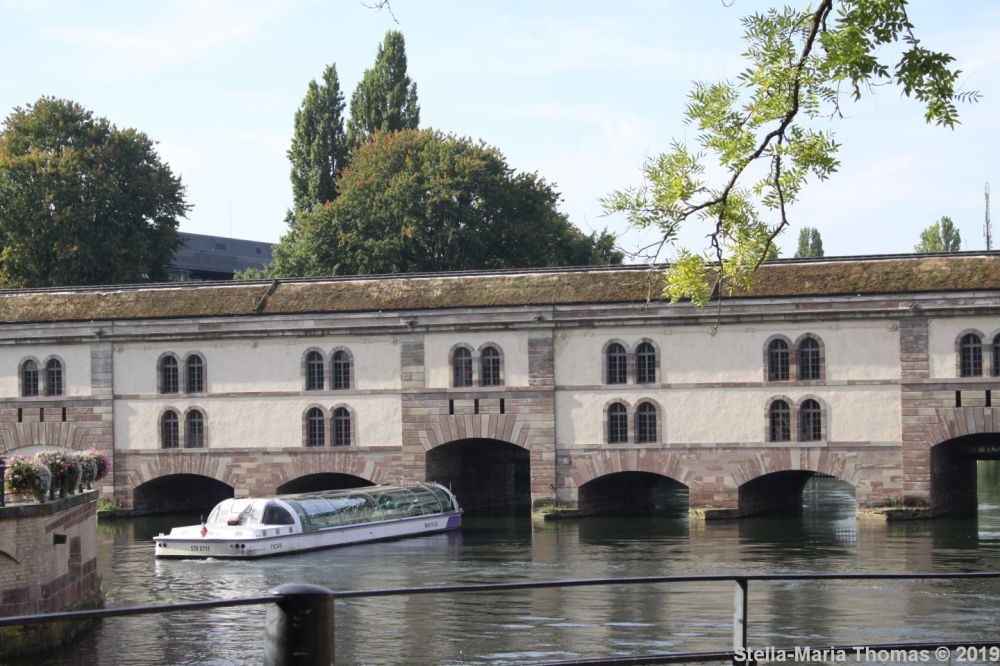
We arrived slightly early at the railway station, which is massive and has been modernised without losing its glorious facade. We battled our way out, identified the business he’d said we should meet outside, and had a swift cup of coffee in a nearby café. The tour started early, with just the two of us booked on it, and we soon found Pierre to be both engaged and engaging, with some entertaining anecdotes to share along with the more basic history of the city. We started over by the water and the Barrage Vauban, a 17th century covered bridge and walkway across the river, where the old city walls used to be (complete with towers) as we headed into the old town, pretty much the area shown on this map inside the blue outlines of the River Ill and the canals which ring it.
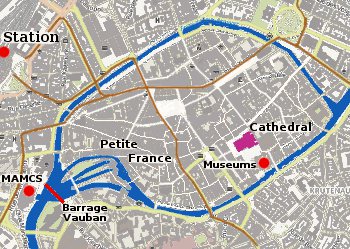
The barrage was built to strengthen the city’s defences and the arches under it could be closed if enemies approached, cutting off their advance by flooding the land to the south.

Three massive square watch towers still stand as part of the ponts-couverts (which are no longer covered, despite the name) and are the last remnants of the medieval city walls on this side of the historic old town (there are two more towers).

It’s a very compact area and you can very easily walk across it with ease, even on a day as hot as the one we were experiencing. This is known as the Grande Île, and it will come as no surprise to anyone who knows it to discover it is another UNESCO World Heritage site. Petite France was our next stopping off point, the area now stunningly attractive, but named for the hospital there which served to treat soldiers suffering from the “French disease”, as syphilis was euphemistically known back in the day!

Petite France is probably the sight that most people associate with Strasbourg, which is ironic. In the past it was desperately poor, and, given that the tanning industry was based there, desperately smelly too. The reason they set up their businesses at this point was the power of three of the downward flowing branches of the Ill where a drop of 1.8 metres created powerful waterfalls which could be used to power mills.

The area is now a magnet for tourists, crowding round the view points, getting on the “fly”-boats and tripping each other up trying to get the perfect selfie. I imagine it’s hell in July and August, but we’d made an early start and it was mid-September so it wasn’t too bad. There’s even a revolving bridge (the Pont du Faisan) that is opened to let the boats through, and which appealed to the technical side of my brain.

Pierre led us along rue des Dentelles where we stopped at one of the gourmet hotspots Pierre wanted to show us, an utterly gorgeous shop selling the most delicious gingerbread in various flavours and varieties. Once inside Mireille Oster we were invited to identify the seven spices they use in their classic gingerbread, and the process was explained to us. We didn’t want to carry anything with us all day so we took a card and made a note to go back the following day after the wine tour we were going on.

Next Pierre showed us the Tanners’ House, which is probably one of, if not the, oldest houses in Strasbourg. As such it’s of great interest, though sadly you can’t go inside. We were also distracted by an hotel on the other side of the road that looked rather wonderful, and would tempt me to return I think, the Bouclier d’Or. Looks like our sort of place!

Next we headed to Saint Thomas’ Church, a solidly imposing fortified church belonging to the Lutheran congregation and sometimes known as the Protestant Cathedral since the actual cathedral was handed back to the Catholics during Strasbourg’s complicated past.

Saint Thomas’ is remarkable for a number of things, not least that it contains the Mausoleum of the Marshall of Saxony, which we did not get to see, because we just didn’t have time. but my god it’s flashy!

It’s a five-naved hall church, which is unusual, and it’s the oldest one in what was at one point (more than one if you look at it in a certain light) south-west Germany, and it’s very beautiful in form. The current building is on the site of an earlier church that burned down, and was started in 1196 and only completed in 1521. It looks impressive both inside and out despite having taken so long to build. We made a mental note to drop back in if we could, but there was so much to see that it ended up not happening.

We next walked along the river bank, which has been cleaned up and pedestrianised, and is now a place to amble, stop, relax and on such a fine day, picnic or just enjoy a drink. We stuck our heads into the courtyard of one of the university buildings, where it seems Albert Schweitzer, one of Strasbourg’s more famous sons, was at one point resident.
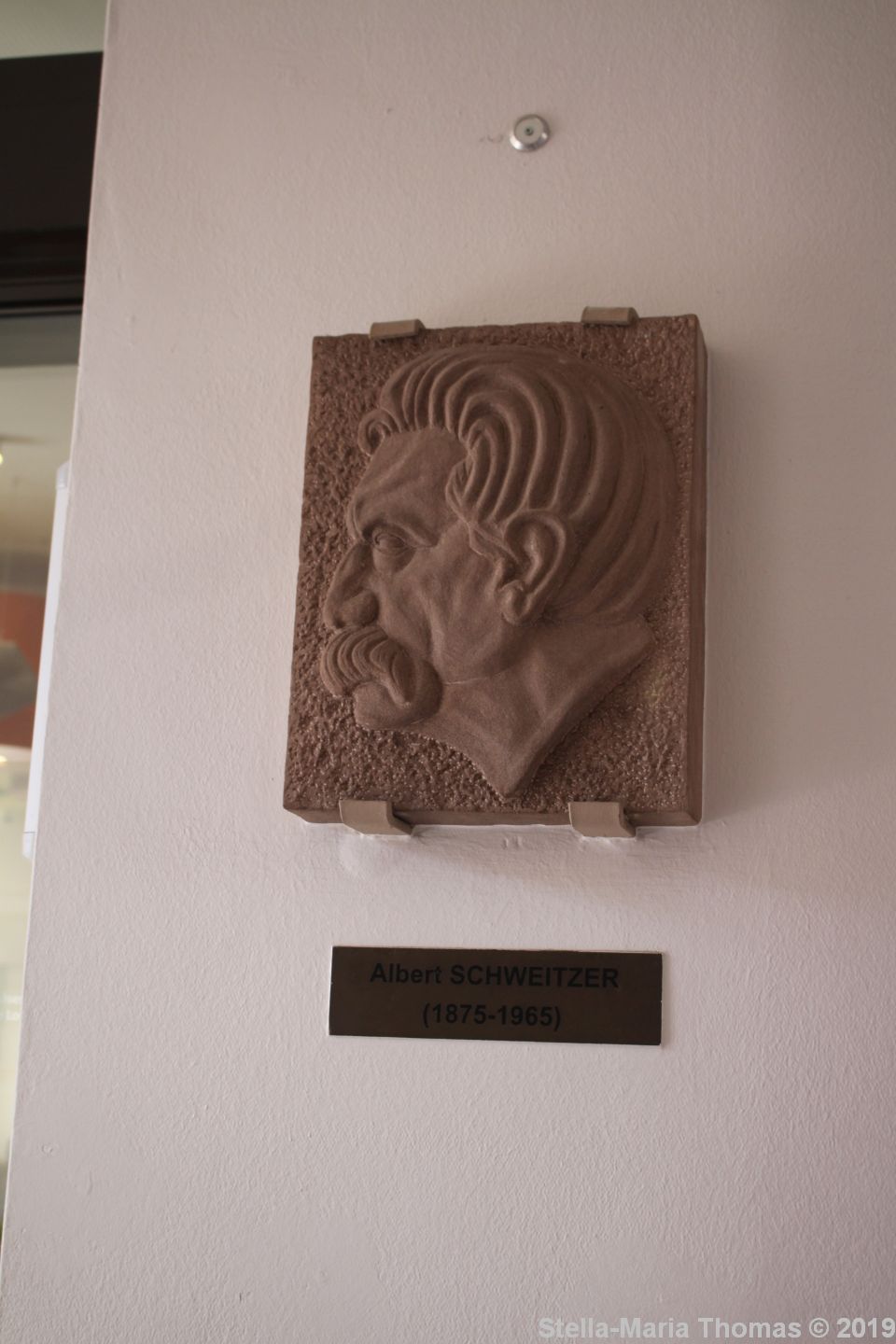
It now has a student’s restaurant, which seemed popular based on the queue of young people hanging around waiting for it to open for lunch. From there we walked towards the Pont du Corbeau, a place where people convicted of infanticide or parricide would be executed by drowning during the Middle Ages, as pointed out in a notice near the bridge. Pierre pointed out the former Customs House, dating back to the 14th Century, and which has a terrace overlooking the water that is apparently now a bar and restaurant.

Also in this section of town is the wine cellar of Strasbourg Hospital, which dates back to 1395, and claims to have the oldest barrel of wine in the word, which dates back to 1472. We learned more about this the following day so I’ll just park it for now and return to it later. We also accidentally found the Cour du Corbeau, which is a fine example of Renaissance architecture. It served as a postal relay and hotel for around 300 years and counted Frederick the Great of Prussia, Austria’s Josef II, Jean-Jacques Rousseau and Alexandre Dumas among many distinguished guests. From 1852 to 1982 it served as a glazier’s and then started to fall into serious disrepair. It was almost lost until a group of developers (Scharf Immobilier, Foncière de la Montagne Verte, Histoire & Patrimoine) bought the whole collection of buildings that constituted the Cour du Corbeau and spent two year’s renovating it. The resulting MGallery hotel looks glorious and was another to end up on our “another time we may well have to stay here” list.

Via the Alsacian Museum (which was going to be open the following day if we could somehow pack it into an already full schedule) – and which looked rather wonderful – we crossed the water back into the main old town, walking round the Palais Rohan, an 18th century building which is also a museum, or rather three museums. The palace itself was built between 1732 and 1742 as the residence of the prince-bishops. It now houses the Museum of Decorative Arts, the Archaeologcal Museum and the Museum of Fine Arts.

Bypassing the Quai des Pêcheurs for now, we needed lunch! Pierre took us to Au Brasseur which specialises in brewing its own beer, and serving a number of Alsacien specialities, including many different flammekuechen, including the classic, which was where we started.

It went very well with one of their blonde beers.

Slightly less successful was the sweet version we went for, with apples and calvados. The problem was that the waitress had only served one before and she couldn’t ignite the calvados no matter how she tried. A further application of spirits also didn’t work and left the dish doused in alcohol and unlit. It was tasty but not how it was meant to be.

Lunch over we set off to walk some more, and Pierre told us about the connection between the Swiss city of Zurich and Strasbourg. The two cities originally formed an alliance in 1253, the Rheinischen Städtebund, and resulted in the episode of what is called the Hirsebreifahrt in 1456, when the Swiss made the claim that if Strasbourg was besieged, they would be able to get there fast enough that if they set off with a pot of warm millet porridge, it would still be warm when it reached Strasbourg and promptly set out to prove it. They still do it, but the last one was in 2016 and the next will be in 2026 so you’ll have to be patient.
He also pointed out the very oddly off centre St William’s Church, a lopsided Gothic church which apparently has a sumptuous interior combining Gothic and Baroque styles, and has fabulous acoustics that mean their choir is one of the leading choirs of the region, whose choirmasters have included Wilhelm Furtwangler and John Eliot Gardiner.

Continuing on, with a quick look at the the Imperial quarter, built in the wake of the 1870 siege and eventual defeat of the French that saw Strasbourg become German. This was in effect an extension of the city outside its previous limits with a raft of official buildings (imperial palace, ministeries, regional assembly headquarters, library and university) as well as residential areas of social and private housing later on. It’s all very impressive.

Mind you there’s still room for the weird. Neither Pierre nor I could explain this, around the base of a tree that had been blown down in a storm.

A further short walk ensued, along the massive Place Broglie bordered by the Opera House, the City Hall, the Governor’s Palace, the Prefect’s Palace, the Strasbourg building of the Banque de France and the historic Mess building. It’s really gorgeous, and is dotted with things to see, including the fontaine de Janus, designed by another of Strasbourg’s famous sons, Tomi Ungerer. It was inaugurated in 1988, for the 2000th anniversary of the first mention of Argentoratum, the Roman settlement on the site.

At the site of the current Banque de France building (a grand Louis XV style edifice from 1925–1927) once stood the birthplace of Charles de Foucauld as well as the house of Philippe-Frédéric de Dietrich where Rouget de l’Isle reportedly sang the Marseillaise for the first time.

And then it was back to food. Pierre took us to a bakery because we needed to try a bretzel. I’m not going to get into a discussion of the origin of preztels, bretzels or whatever you want to call them, because it seems to me that there are at least as many versions as there are bakers, possibly more. Suffice it to say that the pretzel has an emblem of bakers and their guilds since at least the 12th century, and they are regarded as having religious significance because pretzels made using only flour and water could be eaten during Lent. Suffice it to say that Pains Westermann make very good ones, though we didn’t eat them until the following day so they probably weren’t at their best.

From here we crossed the street to a chocolate shop, Maison Caffet. I’m not the world’s biggest chocolate lover, but I do love good chocolate, and these guys have it in abundance. We tried a number of things including chocolates, macarons and eclairs, in amaing flavours. Again, we were sent on our way with a smart box containing two eclairs, one pistachio and one salted caramel, which we would eat for dessert that night.

We had now been with Pierre for at least an hour longer than scheduled, largely because he was so interesting and entertaining and we’d found a lot of common ground. He now took us to the Cathedral where, after he’d imparted a few more entertaining snippets including how potential mayors of Strasbourg had to be thing enough to fit through a gap between a pillar and and the wall of a building, we said our goodbyes and he left us to visit the cathedral on our own.

Its described as an outstanding masterpiece of Gothic art and I’m in complete agreement. The construction of the original Romanesque cathedral began in 1015, while the spire of the current building was completed in 1439 and it utterly dominates the space it is in. There are some fantastic sculptures on the cathedral’s facade, including some downright rude ones, which you should be able to see here. Just look for the bared backside…
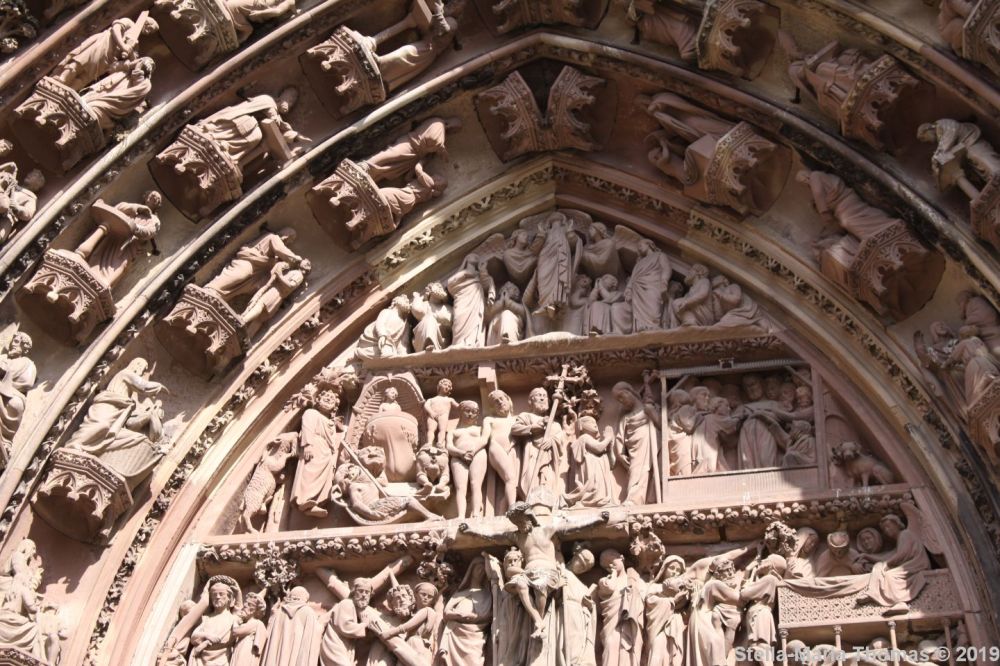
Inside it has pretty much everything you could want in a medieval cathedral, from a rose window to a Renaissance astronomical clock.

It also has access to its tower, via 320 steps. Lynne doesn’t do well with heights and basically told me I was on my own. I went for it, and it was damned hard work, but it was also worth it. You can see for miles, to the Vosges, the Black Forest and the Swiss Alps on a clear day.

It also provides an excellent view of the old town, and has been used as a fire watch point for a very long time (it still is). Once I’d got my breath back I clambered back down, getting some good views of the roof top and the buttresses as I did so.

It was still hot and sweaty out so we decided we’d join one of the “fly” boat tours, provided there was one that had an open top. It turned out there was one leaving on 20 minutes so we made our way down to the landing stage and joined the tour. It was restful, satisfying, and took us past the EU buildings, which we would almost certainly not have got to under our own power.

After that we meandered back to the tram stop and headed for the apartment, ready to shower and head back out for dinner at Umami.































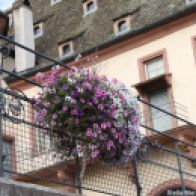







































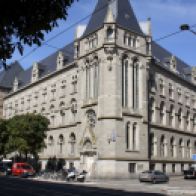



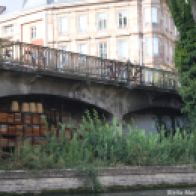













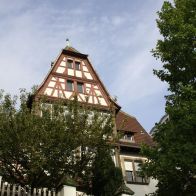































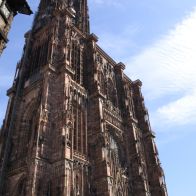















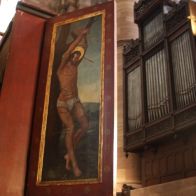


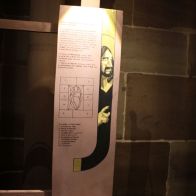

































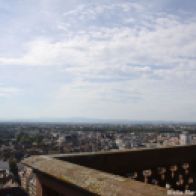
















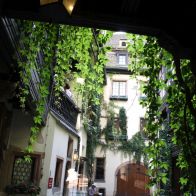





















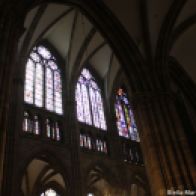






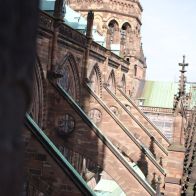




















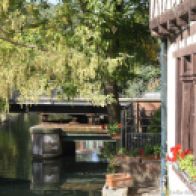






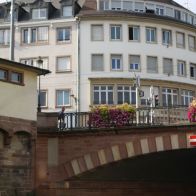



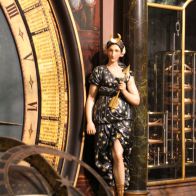































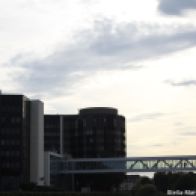

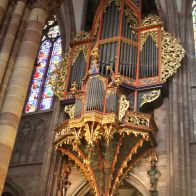


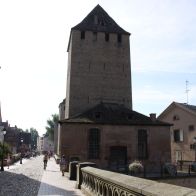
























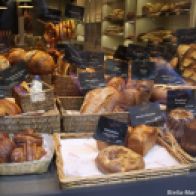

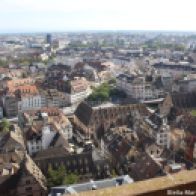















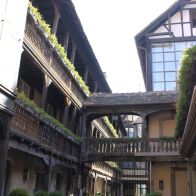

















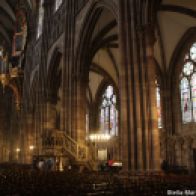

What an absolutely astounding cathedral.
LikeLike
Isn’t it just? Apparently there are several other spectacular churches in Strasbourg that we didn’t get to. I think it warrants a longer stay.
LikeLike
I enjoyed the tour Stella it gave me a good memory nudge!
LikeLike
I was surprised by just how glorious a city Strasbourg is. I’d like to go back. But then I’d like to go back to the whole Alsace/Baden area. It’s glorious!
LikeLike
Also an interesting history being pulled back and forth between France and Germany.
LikeLike
I get the distinct impression that a lot of the locals think of themselves as Alsacien first and that being German, then French, then German, then French is just something that happened to them that they’d prefer to ignore.
LikeLiked by 1 person